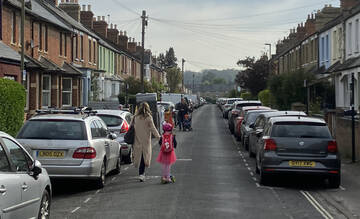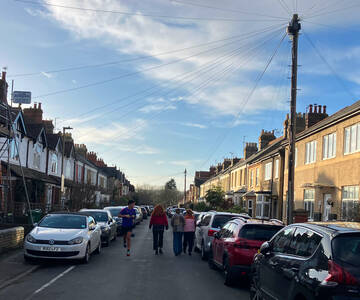Despite the research, I had always downplayed the psychological and social gains from traffic reduction, thinking of them as secondary to health improvements from increased physical activity - and perhaps as a bit "soft" and hard to measure. But my experience with the East Oxford Low Traffic Neighbourhoods has made me rethink this.
My daughter (now 10) walks to and from school by herself and likes to dawdle on her way, and I've come to realise that the time to herself, in which she can unwind and relax, is at least as important as the physical exercise she gets. There are now nine year olds cycling — and many more walking — unaccompanied to her school (Larkrise) and three and four year olds cycling alongside their parents to the Comper nursery near us. That's good for their fitness, but perhaps even more important for their independence and mental health.
It is now much easier to stand around and talk, both to neighbours and to people met while walking or cycling. Before the LTNs, not only was there too much traffic noise and pollution for that to be comfortable, especially where I am on Howard St, but often there wasn't space to stop without blocking the pavement. Now people can stand on the carriageway if they need to - and the carriageway is used by people riding mobility scooters, pushing prams, and walking side-by-side so they can talk to one another, especially on narrow streets where parking blocks the pavements. (One photo is from Charles St, the other from Fairacres St in the "old" LTN of Iffley Fields, on the other side of Iffley Rd, created when bollards were put in on Meadow Lane over twenty years ago.)
It's not something I had expected at all, but I find myself walking to the shops on Cowley Rd now instead of cycling, because the walk is so much more pleasant than it used to be that it is now something to enjoy in its own right. That may not help with environmental sustainability, but it means I'm out and about, in the neighbourhood, for twenty minutes instead of five, which contributes to community safety and social connectivity. (It also means I'm walking past shops and more likely to make impromptu purchases.)
And the gains here are not losses elsewhere. Iffley Rd carries nearly 10,000 motor vehicles a day and is up to nine metres across, so no one is ever going to hold conversations across it, let their children play on it, or use a wheelchair on it - and a thousand more or fewer cars a day won't change that. It also has wide footways and cycle lanes, so people walking along it are not right next to motor traffic and can walk side-by-side.
The classic research on social contact in streets with different traffic levels, by Donald Appleyard, has been replicated in Bristol:
"The results confirmed that Appleyard's findings are applicable to the UK in the 21st century; specifically that the number of friends and acquaintances reported by residents was significantly lower on streets with higher volumes of motor traffic. The extent of people's "home territories" also diminished as motor traffic increased. Other notable outcomes from the research include the finding that individuals' perceptions of road safety in their neighbourhood may be disproportionately influenced by the traffic conditions on their street of residence, especially affecting the degree of independence granted to children. The findings are considered against the context of existing policy solutions to reduce traffic impacts, leading to the conclusion that the tools exist to reclaim urban residential neighbourhoods from traffic, but this will require considerable political will."


